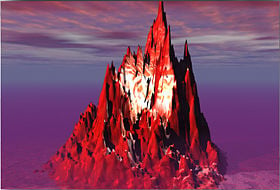Difference between revisions of "Virtual museum" - New World Encyclopedia
Keisuke Noda (talk | contribs) |
Keisuke Noda (talk | contribs) |
||
| Line 98: | Line 98: | ||
*[http://www.io.tudelft.nl/public/vdm/The IDE Virtual Design Museum] | *[http://www.io.tudelft.nl/public/vdm/The IDE Virtual Design Museum] | ||
*[http://www.typewritermuseum.org/ Virtual Typewriter Museum] | *[http://www.typewritermuseum.org/ Virtual Typewriter Museum] | ||
| − | *[http://www.virtualmuseum.ca/ Musée Virtuel du Canada (MVC)/Virtual Museum of Canada (VMC) | + | *[http://www.virtualmuseum.ca/ Musée Virtuel du Canada (MVC)/Virtual Museum of Canada (VMC)] |
[[Category:Politics and social sciences]] | [[Category:Politics and social sciences]] | ||
[[Category:Education]] | [[Category:Education]] | ||
Revision as of 03:04, 2 August 2008
A virtual museum is a museum that houses collections in digital form and exhibits them via Internet. Most of virtual museums are a part of physically existing museums that hold actual collections as physical objects. A virtual museum often started from a simple website and grew into a fully functional entity.
Some virtual museums exist in virtual environment alone without physical facility. Museum of Computer Art (MOCA) (Museum of Computer Art) is an example of this type. MOCA's collections are digital arts created by computer graphic technologies.
A virtual museum can house digitally produced collections such as music, moving images, as well as still images and documents. Due to hyperlinking capabilities, the exhibit can be linked to background information, related works, and other relevant sources. Some museum such as Musée Virtuel du Canada (MVC)/Virtual Museum of Canada (VMC) offer a capability for a user to create his or her personal virtual museum on their site. Unlike physical museum, a virtual museum can be open twenty-four hours, seven days a week, with indefinite number of visitors from all over the world.
Although a virtual museum is still at an early stage of development, many museums are actively developing this area. Some individuals such as artists and photographers also create personal virtual museum and exhibit his or her own collections online. Artists, who did not have a chance of exhibiting their works in the past due to lack of financial resources, have better opportunity in virtual environments.
Characteristics
A virtual museum has a number of distinct characteristics. Some of main features are:
Collections
A collection can include moving images, sound files such as music and narration as well as still images and documents or a combination of these.
Integration and Interaction
Each exhibit can be hyperlinked to other relevant information sources such as background information, the artist's biography with photos, other works by the same artist, and a link to collections held at other museums.
Within web environments, a museum can easily integrate education, research, and virtual experiences.
Global visitors
Physical limitation of facilities does not exit in virtual museum. Exhibit can be viewed by indefinite number of visitors from all over the world. Even a small museum located in a remote area can offer its service and exhibit its collection to a global audience. Even an individual artist can establish his or her own mini-virtual museum and exhibit collections to a broader audience.
Costs
Establishing a decent museum as a physical facility requires a prohibitive amount of funds which make it nearly impossible to open a new museum for ordinary individuals or institutions or communities. The creation of a virtual museum, however, is possible with far lower cost than that of regular museum. This is another reason why many individuals, institutions, and communities open virtual museums. For established museums, virtual museum is an extended exhibits and museum operations. For individuals or institutions, it is an opportunity to establish a new museum. For example, Lin Hsin Hsin, an artist in Singapore, established Lin Hsin Hsin Art Museum (a virtual museum) as early as 1994. She is one of early pioneers to establish virtual museum.[1]
Accessibility
A virtual museum is generally open twenty-four hours and seven days as a week. The National Virtual Museum of United Kingdom is also "Hour Museum."
Preservation
One of the most important components of museum operation is preservation and security. Unlike libraries, collections are not reproduceable. Temparature, humidity, lightning, and human physical contacts with the collection are all carefully restricted. Virtual collections, however, are free from those preservation and security problems.
Pioneers
Technology
The technology of virtual museum builds on the concept of interactive environments; it can support interactive exhibitions that display visual representations of the museum by a 3D architectural metaphor providing a sense of place using various spatial references. Usually using 3D modelling, VRML (Virtual Reality Modelling Language) authoring tool for viewing. There have been introduced various kinds of imaging techniques for building virtual museums, such as, infrared reflectography, X-Ray imaging, 3D laser scanning, IBMR (Image Based Rendering and Modelling) techniques. In the case of EU-funded projects, the ViHAP3D, a new virtual reality system, for scanning museum artifacts has been developed by EU researchers.
The genre of the virtual museum continues to develop. It is now recognized in the .museum domain hierarchy; see an online list from MuseDoma.
Pioneers
Some of the following museums have been pioneers at developing websites for their collections. A website gradually developed into a virtual museum:
The Natural History Museum of Los Angeles County; the Museum of the History of Science in Oxford (located in one of the earliest purpose-built museum buildings in the world) was also able to initiate a website relatively early because of the advantageous networking facilities and expertise available in their university environment; the Science Museum in London (one of the major science museums in the world), was as well, able to establish an early web presence partly due to the proximity of the Imperial College, but also spurred on by the fact that the Natural History Museum, which is next door, have established the first dedicated museum web server in the United Kingdom just before them.
Another early example of an online exhibition with the Library of Congress (U.S.) backing it, was the EXPO Ticket Office with exhibits including a Vatican Exhibit and even a virtual "restaurant" and "post office." This looks very simplistic now, but was novel in 1991. Some others have been produced by enthusiastic individuals such as the Lin Hsin Hsin Art Museum; the UK's 24 Hour Museum and the Virtual Museum of Canada, are professional endeavors.
Examples of Virtual Museum
Most of the museums today have virtual presence and exhibitions. Many of them call it "virtual museum." The followings are some samples.
Museum of computer art
One of the most successful and comprehensive of the virtual museums is the Museum of Computer Art, often identified by its acronym MOCA. It was founded in 1993 and is directed by Don Archer. It operates as a non-profit corporation under charter from the Department of Education of New York State (US). It was awarded .museum top-level domain (TLD) status by the Museum Domain Management Association (MuseDoma) in 2002.
Virtual Museum of Canada
The Virtual Museum of Canada (VMC) is Canada's national virtual museum. With over 2,500 Canadian museums, the VMC brings together Canada's museums regardless of size or geographical location. The VMC includes virtual exhibits, free online games, educational material, and over 580000 images. The resources are bilingual -available in both French and English. While the content on the Virtual Museum of Canada is created by Canadian museums, it is administered by the Canadian Heritage Information Network which is an agency within the department of Canadian Heritage.
The Virtual Museum of Canada provides an online environment for Canadian communities to tell their stories and preserve their history. One of the most popular sections of the VMC is their Community Memories section. This is a place where smaller Canadian community museums, who are mostly volunteer run, can create online exhibits about their history.
Virtual Museum of New France
The Virtual Museum of New France (French: Le Musée virtuel de la Nouvelle-France) was established by the Canadian Museum of Civilization Corporation on January 22, 1997. As an entirely virtual museum, it has no physical exhibits and only exists on the World Wide Web. The mission of the museum is to promote awareness of all facets of life in New France, as it existed from the 16th century until the Treaty of Paris (1763). When it opened, it claimed to be "the only museum without walls in the world."[2]
See also
- Virtual Library museums pages
- Virtual Museum of Canada
- Virtual Museum of Computing
- Virtual Museum of New France
Notes
- ↑ Lin Hsin Hsin, National Library Board, Singapore. Retrieved August 2, 2008.
- ↑ Canadian Museum of Civilization (1997-01-21). Multimedia Versatility at the Canadian Museum of Civilization in Hull: Art, Technology and Education!. Press release. Retrieved on 2006-08-03.
ReferencesISBN links support NWE through referral fees
External links
All links retrieved August 2, 2008.
- ABC Typography: A Virtual Museum of Typography
- Virtual Library Museums Pages (VLmp): A Distributed Directory of On-line Museums
- Virtual Museum of Nautical Archaeology
- Virtual Instrument Museum
- Virtual Museum of New France
- IDE Virtual Design Museum
- Virtual Typewriter Museum
- Musée Virtuel du Canada (MVC)/Virtual Museum of Canada (VMC)
Credits
New World Encyclopedia writers and editors rewrote and completed the Wikipedia article in accordance with New World Encyclopedia standards. This article abides by terms of the Creative Commons CC-by-sa 3.0 License (CC-by-sa), which may be used and disseminated with proper attribution. Credit is due under the terms of this license that can reference both the New World Encyclopedia contributors and the selfless volunteer contributors of the Wikimedia Foundation. To cite this article click here for a list of acceptable citing formats.The history of earlier contributions by wikipedians is accessible to researchers here:
- Virtual_museum history
- Virtual_Museum_of_Canada history
- Virtual_Museum_of_Computing history
- Virtual_Museum_of_New_France history
The history of this article since it was imported to New World Encyclopedia:
Note: Some restrictions may apply to use of individual images which are separately licensed.

